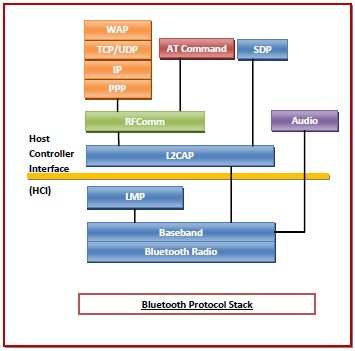
 Data Structure
Data Structure Networking
Networking RDBMS
RDBMS Operating System
Operating System Java
Java MS Excel
MS Excel iOS
iOS HTML
HTML CSS
CSS Android
Android Python
Python C Programming
C Programming C++
C++ C#
C# MongoDB
MongoDB MySQL
MySQL Javascript
Javascript PHP
PHPPhysics
Chemistry
Biology
Mathematics
English
Economics
Psychology
Social Studies
Fashion Studies
Legal Studies
- Selected Reading
- UPSC IAS Exams Notes
- Developer's Best Practices
- Questions and Answers
- Effective Resume Writing
- HR Interview Questions
- Computer Glossary
- Who is Who
The Bluetooth Protocol Stack
Bluetooth network technology connects mobile devices wirelessly over a short-range to form a personal area network (PAN). The Bluetooth architecture has its own independent model with a stack of protocols, instead of following the standard OSI model or TCP/IP model. Another unique feature is that it is not mandatory for all the devices in the Bluetooth system to use all the protocols in the stack. This is because Bluetooth is designed to be used by myriad applications and the application designates which part of the protocol stack is to be used.
Protocols in the Bluetooth Protocol Stack
-
Core protocols − This includes Bluetooth radio, Baseband, Link Manager Protocol (LMP), Logical Link Control and Adaptation Protocol (L2CAP), and Service Discovery Protocol (SDP).
-
Cable Replacement Protocol − This includes Radio Frequency Communications (RFComm) protocol. It is short for Radio Frontend Component. It provides a serial interface with WAP.
-
Adopted Protocols − These are the protocols that are adopted from standard models. The commonly adopted protocols used in Bluetooth are Point-to-Point Protocol (PPP), Internet Protocol (IP), User Datagram Protocol (UDP), Transmission Control Protocol (TCP), and Wireless Application Protocol (WAP).
-
AT Commands − ATtention command set.
The following diagram shows the Bluetooth protocol stack −

Functions of the Core Protocols
-
Radio − This is a physical layer equivalent protocol that lays down the physical structure and specifications for transmission of radio waves. It defines air interface, frequency bands, frequency hopping specifications and modulation techniques.
-
Baseband − This protocol takes the services of radio protocol. It defines the addressing scheme, packet frame format, timing, and power control algorithms.
-
Link Manager Protocol (LMP) − LMP establishes logical links between Bluetooth devices and maintains the links for enabling communications. The other main functions of LMP are device authentication, message encryption, and negotiation of packet sizes.
-
Logical Link Control and Adaptation Protocol (L2CAP) − L2CAP provides adaption between upper layer frame and baseband layer frame format. L2CAP provides support for both connection-oriented as well as connectionless services.
-
Service Discovery Protocol (SDP)− SDP takes care of service-related queries like device information so as to establish a connection between contending Bluetooth devices.

